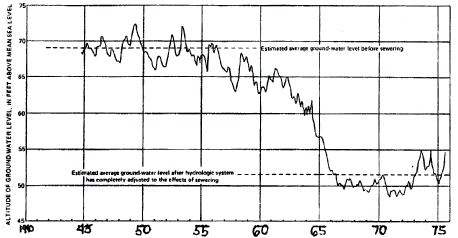Transient Analytical Solutions are often defined in terms of (drawdown), s, rather than head so that a hydrostatic initial condition can be used and superposition can be called upon to apply the results to alternative initial conditions if the problem is linear.
If a solution is expressed in terms of head rather than drawdown, then the initial conditions must be defined. There are two important issues to keep in mind:
1. Initial material properties and boundary conditions must be consistent with the initial heads. If you start with initial heads that are contoured from field measurements and you do not apply a stress to the system, the heads will adjust to the properties and boundaries, so you are inadvertently introducing a stress by defining inconsistent values for starting conditions. The most common way to deal with this problem is to calculate a pre-stress steady state solution for use as initial heads.
2. If the field system being simulated is not in equilibrium, an earlier steady state condition must be identified and defined as a starting point. All subsequent stresses must be simulated from the time when equilibrium prevailed until time when the initial conditions are needed is reached, then the early stresses must continue along with the new stress of interest if the early stresses continue in the field.
A classic example is this hydrograph of a well on Long Island displaying the impact of sewering which started in the mid 50's and was completed in mid-60's.

The upper dashed line represents a long term steady state condition. Yes there are daily and seasonal variations but the average values are relatively constant in time. The lower dashed line represents the new long term steady state condition that prevails after the full impact of sewering has been realized.
The water levels decline as a result of sewering because recharge that used to enter the ground water via septic tanks now routed away by the sewers.
Suppose you wanted to simulate the impact of a proposed municipal water supply well that would go on line in 1962. In order to obtain a consistent set of starting values for initial conditions in 1962, it would be necessary to simulate the early equilibrium that prevailed until 1955, add the stress of the gradually reducing recharge in space through time until reaching 1967, then continue simulating the reductions in recharge along with the addition of the pumping well.
Another concept that can be illustrated by this diagram is: If you had water level data from a number of wells prior to 1955, the average of those values would reflect the average water levels during the early period for one set of boundary conditions and stresses. However if data from 1950 through 1975 were mixed together and averaged, the result will NOT reflect a set of boundary conditions and stresses that occurred together in the field. It is vital that you develop hydrographs of an area and come to understand these transitions before undertaking an elaborate modeling project.
Be that as it may, for now, we are using relatively simple solutions that rely on hydrostatic initial conditions as illustrated by the following examples.
First let's explore transient flow to parallel drains. This is a common problem in the agricultural industry.